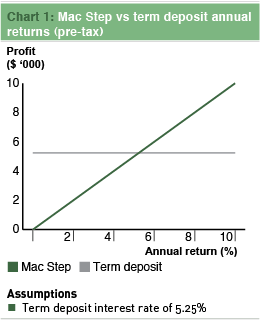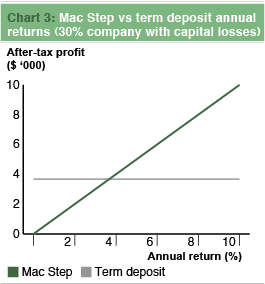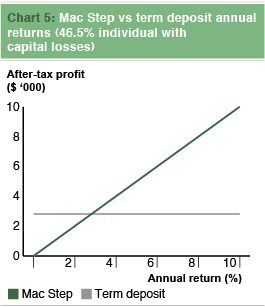Getting to grips with Macquarie Step
Key Points
- Macquarie Step is the classic, unleveraged CPP
- Similar play to Westpac Protected Equity Loan, without the cost of leverage
- May hit the sweet spot for investors with the right attributes
The Product
The latest version of Macquarie Step offers investors ‘a strategic investment solution with capital protection at maturity’.
It’s simpler than it sounds. In our articles Capital protected products: A dead end and Capital protected products: Will the tax benefits save you? we outlined the ‘typical CPP’. This is it.
Macquarie Step (Series XI to XIII) offers investors the opportunity to enter into a DPA whereby Macquarie agrees to repay your original investment after three (or three and a half) years plus a return linked to the performance of any of the ASX 200 Price Index, the S&P 500 Price Index, or a 50/50 mix of the S&P 500 and the PIMCO Bond Fund.
As an unleveraged product, Step has a significant advantage over products like Westpac PEL or Macquarie Flexi (the leveraged sibling of Step)—there is no interest cost dragging down returns. Step (at least the equity index versions) still suffers from the ‘missing dividends’ problem—making it unappealing as a share alternative, or to investors not concerned with capital gains—but the lower costs give it wider potential appeal.
The Proposition
Step offers returns in the form of capital gains on the upside, with capital protection on the downside. Effectively, it’s a one-way punt on generating capital gains.
We’ve long made the point that CPPs don’t stack up on a pre-tax basis. So, for tax indifferent investors—SMSFs and companies for instance—the CPP conundrum remains acute.
But if you have capital losses, or you are simply a bullish (but nervous) individual who gets the benefit of the 50% CGT discount, Step may have something to offer.
In Capital Protected Products: Will the tax benefits save you? we compared a CPP to a 50/50 mix of shares and term deposits. If you are considering Step, please review that analysis.
Rather than repeating it, we’ll take a slightly different tack and compare Step to a term deposit (on a pre-tax and after-tax basis). The following charts show how the tax attributes of the Step investor significantly impact on its attractiveness.
Chart 1 shows how the pre-tax proposition stacks up for a 0% SMSF (or other tax-indifferent investor). Can Step deliver a return greater than a term deposit? The analysis in ‘Capital protected products: A dead end’ suggests that, without dividends, it’s a difficult task.
However, charts 2 to 5 show that, as an investor generates greater after-tax value from their earnings being capital gains, the argument in favour of Step becomes more compelling.
Whereas a 0% SMSF needs Step to generate returns of 5% or more to break even, an individual with capital losses might consider themselves a massive winner at this level. Furthermore, the breakeven point might be less than 3%—depending on the value placed on the investor’s capital losses.
The lower breakeven point and the big pay-off for a winning bet make Step far more attractive to those that can place a high value on the tax benefit of generating capital gains.
What’s the catch?
The main catch is simply that the relevant price index (or PIMCO fund) doesn’t perform and all you get back is your principal. For the tax conscious investor, Step is a reasonable punt on performance. But it’s still a punt.
There’s also a few devils in the detail:
- Credit risk - While we have compared Step to a term deposit, Step doesn’t benefit from the Government guarantee. That means your counterparty risk is increased. In our view, you shouldn’t underestimate the additional risk this introduces (especially the fact that APRA will no longer be ‘protecting’ you). We’ll leave it to you to add a margin to allow for this additional risk, or put it in the ‘unacceptable risk’ category and pass on it altogether.
- Liquidity - Step provides a six-monthly withdrawal option (refer Term Sheet and Section 4.6 of the PDS). While better than nothing, keep in mind that exercising this option requires you to pay all relevant break costs—it is not a free option—and you don’t have the daily liquidity of an ETF or share portfolio. Macquarie also has the ability to terminate the product early (refer Section 4.6.2 of the PDS and the Glossary), although this is a very low risk.
- Timing - As described in the recent article Westpac PEL: Explaining the play, CPPs don’t allow you to control the timing of either the entry or exit of the investment. If you find yourself with an unrealised gain with a few months to maturity, you won’t be able to sell your position (although you could enter into, say, a CFD to hedge).
- Performance caps - Step is subject to caps (for the ASX 200 and S&P 500 versions) on the overall performance. While the higher end of the range is quite generous (180% and 170% respectively), the lower end (145% and 140%) curtails the ability of this product to pay off in a big way. The prior point regarding timing means you can’t get in while the going’s good. But you should be able to talk to Macquarie close to the issue date to get an indication of where the cap is likely to be set.
- Product ruling - Step has recently been issued with an ATO product ruling (PR 2012/21) confirming its tax treatment—particularly that gains should be treated as capital gains. However, the ruling does not apply upon early termination. Seek professional tax advice if you are at all unsure on the tax aspects of this product.
- Foreign exchange - Step features a quirk in the way it pays performance on the S&P 500 and PIMCO fund. Neither are AUD investments. But Step pays you an AUD return by simply applying the percentage return on the reference asset to your AUD investment balance. Your principal isn’t exposed to FX risk.
- Averaging risk - If you elect the Series XIII option—a 50/50 mix of the S&P 500 and the PIMCO fund—you’ll get the average performance of the two and are not capital protected on each component.
Series XIII option
The Series XIII option is interesting. Unlike the various equity indices on which this (and other CPPs are based) the PIMCO fund is ‘total return’—it includes the income on the underlying bonds.
This provides an additional cushion to performance and should increase the likelihood that a positive return—and a concessionally taxed capital gain—is achieved. The PIMCO fund hasn’t had too many negative performance years. The flipside is that a bond strategy is unlikely to shoot the lights out.
We know some Walnut Report members have been thinking about bond funds and ETFs. For this audience, Step provides an opportunity to receive your performance in the form of a capital gain.
Again, there’s a catch. The PIMCO fund only comes as part of a 50/50 mix with the S&P 500. But Macquarie has issued a PIMCO-only version in the past and may well do so again.
Alternative strategies?
Products such as Instreet Yield are simply expensive, complicated options dressed up as an investment. As these products don’t provide a tax angle, option trading is a logical alternative to them. Mind you, most investors, if presented with the option strategy on which Instreet Yield is based, would probably run a mile, and rightly so.
Step is also an option-based product but does feature a tax angle—since option trading doesn’t generate capital gains. For conservative investors not looking to play the tax game, we refer you to our original suggestions in ‘Capital protected products: A dead end’. A conservative portfolio may better serve your needs.
If you have capital losses or want to play the discounted CGT game, Step is an interesting proposition that isn’t really served by alternative means. It’s a take-it-or-leave-it proposition.
Verdict
Step won’t be of interest to everyone. ‘Pre-tax’ investors in particular are generally better off sticking with a conservative portfolio. Others might be nervous about the lack of Government guarantee.
But if you’re invested in term deposits and have capital losses, you might consider Step.











